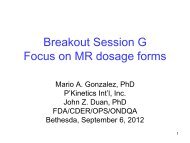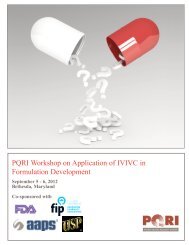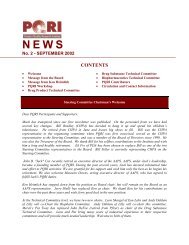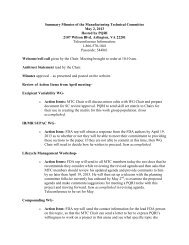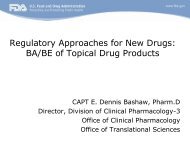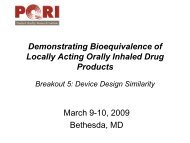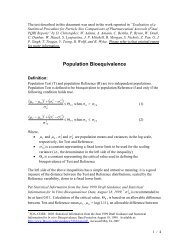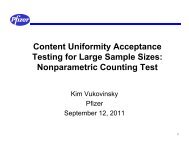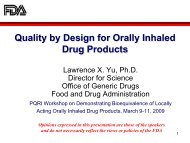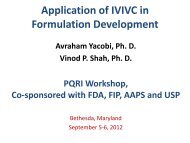FDA's Experience on IVIVC â Generic Drugs - PQRI
FDA's Experience on IVIVC â Generic Drugs - PQRI
FDA's Experience on IVIVC â Generic Drugs - PQRI
You also want an ePaper? Increase the reach of your titles
YUMPU automatically turns print PDFs into web optimized ePapers that Google loves.
FDA’s <str<strong>on</strong>g>Experience</str<strong>on</strong>g> <strong>on</strong> <strong>IVIVC</strong> –<strong>Generic</strong> <strong>Drugs</strong>Barbara M. Davit, Ph.D., J.D., DirectorDivisi<strong>on</strong> of Bioequivalence II, Office of <strong>Generic</strong> <strong>Drugs</strong>Center for Drug Evaluati<strong>on</strong> and Research (CDER)United States Food and Drug Administrati<strong>on</strong> (US-FDA)barbara.davit@fda.hhs.gov<strong>PQRI</strong> Workshop <strong>on</strong> Applicati<strong>on</strong> of <strong>IVIVC</strong> in Formulati<strong>on</strong> DevelopmentCo-sp<strong>on</strong>sored with FDA/FIP/AAPS/USPSept. 5-6, 2012Bethesda, MD1
Outline• Review of Guidance for Industry <strong>on</strong> <strong>IVIVC</strong>• Uses of in vitro-in vivo correlati<strong>on</strong> (<strong>IVIVC</strong>) ingeneric drug development• Case studies• Use of in vitro-in vivo relati<strong>on</strong>ships (IVIVR)in generic drug development• Summary and c<strong>on</strong>clusi<strong>on</strong>s2
Review of FDA Guidance forIndustry <strong>on</strong> <strong>IVIVC</strong>3
FDA Guidance for Industry• Extended-Release Oral Dosage Forms:Development, Evaluati<strong>on</strong>, and Applicati<strong>on</strong>of In Vitro/In Vivo Correlati<strong>on</strong>s (9/97)• C<strong>on</strong>tent– Recommendati<strong>on</strong>s for developing the <strong>IVIVC</strong>– <strong>IVIVC</strong> applicati<strong>on</strong>s4
Recommendati<strong>on</strong>s fordeveloping the <strong>IVIVC</strong>• Level A correlati<strong>on</strong>s are most useful• Level C correlati<strong>on</strong>s can be useful in earlydevelopment stages• Level B correlati<strong>on</strong>s are least useful• Develop correlati<strong>on</strong> with 3 or moreformulati<strong>on</strong>s with differing release rates– Two may be acceptable in some situati<strong>on</strong>s• In vivo study = single-dose crossover5
Recommendati<strong>on</strong>s fordeveloping the <strong>IVIVC</strong>• Develop in vitro dissoluti<strong>on</strong> methodologythat can adequately discriminate am<strong>on</strong>gformulati<strong>on</strong>s• Evaluate both internal and externalpredictability• For a generic product, bioequivalence(BE) to the reference product should beestablished prior to <strong>IVIVC</strong> study6
Uses of <strong>IVIVC</strong> in generic drugdevelopment7
Case studies9
Case AObjective: support dissoluti<strong>on</strong> specificati<strong>on</strong>Applicant’s approach• Formulati<strong>on</strong>s tested were to-bemarketed(TBM) generic, a pilotformulati<strong>on</strong>, and an IRformulati<strong>on</strong>• Determined Level A correlati<strong>on</strong>• Assessed internal predictability• C<strong>on</strong>cluded that <strong>IVIVC</strong> datasupported proposed dissoluti<strong>on</strong>specificati<strong>on</strong>sFDA’s assessment• Applicant submitted <strong>on</strong>ly asummary report of <strong>IVIVC</strong> data;full report was needed to makeassessment• A manufacturer other than theapplicant produced the IRformulati<strong>on</strong> used in the <strong>IVIVC</strong>• No external predictability datasubmittedOutcome: applicant withdrew amendment forother reas<strong>on</strong>s 10
Case BObjective: challenge results of a failed BE studyApplicant’s approach• Used lower strength of TBMproduct line as faster-releasingformulati<strong>on</strong>• Used higher strength of TBMproduct line as slower-releasingformulati<strong>on</strong>• Performed Level A correlati<strong>on</strong>• Assessed internal and externalpredictabilityFDA’s assessment• Deemed external predictabilitystudy as acceptable• C<strong>on</strong>cluded that dissoluti<strong>on</strong> ratesof the two formulati<strong>on</strong>s did notsupport c<strong>on</strong>clusi<strong>on</strong> that <strong>on</strong>e wasfast-releasing and <strong>on</strong>e wasslow-releasing• Rejected the <strong>IVIVC</strong> proposalOutcome: applicant c<strong>on</strong>ducted a new in vivostudy which met BE acceptance criteria 11
Case CObjective: support changes in dissoluti<strong>on</strong> specificati<strong>on</strong>sApplicant’s approach• Manufactured slow-, mid- andfast-releasing formulati<strong>on</strong>s ofthe drug product• Used these formulati<strong>on</strong>s for invitro and in vivo studies• Developed a Level A correlati<strong>on</strong>• Back-calculated ACU and Cmaxvalues from dissoluti<strong>on</strong>specificati<strong>on</strong> limitsFDA’s assessment• C<strong>on</strong>firmed that the backcalculatedCmax and AUC,determined using the proposeddissoluti<strong>on</strong> specificati<strong>on</strong>s, metBE limits of 80-125%Outcome: FDA c<strong>on</strong>curred with the proposed changesto the dissoluti<strong>on</strong> specificati<strong>on</strong>s 12
Case DObjective: support proposed changes to dissoluti<strong>on</strong>methodApplicant’s approach• Developed a Level A correlati<strong>on</strong>using the applicant’s TBMformulati<strong>on</strong> and the referenceproduct formulati<strong>on</strong>• Did not assess internal orexternal predictabilityFDA’s assessment• <strong>IVIVC</strong> development isformulati<strong>on</strong> specific• It is not appropriate to usedifferent test and referenceformulati<strong>on</strong>s, each from adifferent manufacturer• No internal or externalpredictability data weresubmittedOutcome: applicant withdrew the amendment 13
Case EObjective: to support a Level 3 site changeApplicant’s approach• Manufactured slow-, mid- andfast-releasing formulati<strong>on</strong>s• Used formulati<strong>on</strong>s for in vitroand in vivo studies• C<strong>on</strong>ducted a Level A correlati<strong>on</strong>• Assessed internal and externalpredictabilityFDA’s assessment• Internal and externalpredictability were not c<strong>on</strong>firmed• The “fast” release formulati<strong>on</strong>dissoluti<strong>on</strong> profiles did not differfrom those of the “slow” releasedissoluti<strong>on</strong> profiles, despite thefact that the two formulati<strong>on</strong>sshowed marked differences inAUC and CmaxOutcome: applicant c<strong>on</strong>ducted an in vivo BEstudy to support the Level 3 site change 14
IVIVR15
Uses of IVIVR• Not as robust as an <strong>IVIVC</strong>• Can be an important feature a Quality byDesign (QbD) approach with respect to– <strong>Generic</strong> drug development– Predicti<strong>on</strong> of performance of commercialbatches– Assessment of post-approval changes16
IVIVRExample below taken from “QbD for ANDAs,An Example for Modified-Release DosageForm”, developed by staff from FDA’s Officeof <strong>Generic</strong> <strong>Drugs</strong>17
IVIVR example• Reference product and prototypeformulati<strong>on</strong> F-1 used to optimizedissoluti<strong>on</strong> method (USP Apparatus 3, 10dpm, 250 mL pH 6.8 phosphate buffer)• Dec<strong>on</strong>voluted PK profile of pilotformulati<strong>on</strong> F-1 (not BE to reference) toobtain fracti<strong>on</strong> of in vivo drug release18
IVIVR example• Established IVIVR (y = 1.1114x – 0.1382)to predict plasma c<strong>on</strong>centrati<strong>on</strong> profiles• Developed prototypes F-2 and F-3• C<strong>on</strong>ducted dissoluti<strong>on</strong> studies of F-2, F-3,c<strong>on</strong>voluted data to predict mean in vivo PKprofiles• Simulated virtual trial simulati<strong>on</strong>s viamodeling19
IVIVR example• IVIVR and simulati<strong>on</strong> studies suggestedthat F-2 would be bioequivalent toreference• In vivo BE studies of F-2 and F-3 againstreference c<strong>on</strong>firmed results of IVIVR andsimulati<strong>on</strong> studies• Thus, IVIVR was used to select theoptimal formulati<strong>on</strong> for development20
IVIVR example summaryUse RLD and prototype F1to optimize dissoluti<strong>on</strong>methodSet dissoluti<strong>on</strong> methodDec<strong>on</strong>volute to calculatefracti<strong>on</strong> of in vivo drugreleaseEstablish IVIVRUse IVIVR to developprototypes F2, F3C<strong>on</strong>duct dissoluti<strong>on</strong> studiesof F2 and F3C<strong>on</strong>volute to predict PKprofiles and simulate BEstudy resultsSelect formulati<strong>on</strong>(s)for pivotal BE studiesC<strong>on</strong>duct in vivo studies toc<strong>on</strong>firm BE of F2 and F3Use results of in vivo BEstudy to c<strong>on</strong>firm F todevelop for marketing21
Uses of IVIVR• To perform c<strong>on</strong>voluti<strong>on</strong> of the in vitro datafor reference and prototype genericformulati<strong>on</strong>s• To predict outcome of BE studies usingvarious prototype formulati<strong>on</strong>s• To establish a linkage between exhibit andcommercial batches22
Summary and c<strong>on</strong>clusi<strong>on</strong>s23
Summary and c<strong>on</strong>clusi<strong>on</strong>s• FDA Guidance for Industry providesrecommendati<strong>on</strong>s for properly establishing<strong>IVIVC</strong> of generic modified-release oraldrug products• <strong>IVIVC</strong> can be used to support some postapprovalchanges, and changes indissoluti<strong>on</strong> method/specificati<strong>on</strong>s, formodified-release generic drug products24
Summary and c<strong>on</strong>clusi<strong>on</strong>s• Very few submissi<strong>on</strong>s to FDA’s Office of<strong>Generic</strong> <strong>Drugs</strong> (from 1996-2012)c<strong>on</strong>tained <strong>IVIVC</strong> data, and most were notacceptable• FDA’s Office of <strong>Generic</strong> <strong>Drugs</strong> proposesusing IVIVR as part of a QbD approach fordevelopment of generic modified-releaseformulati<strong>on</strong>s25
References• FDA Guidance for Industry, Extended-Release OralDosage Forms: Development, Evaluati<strong>on</strong>, andApplicati<strong>on</strong> of In Vitro/In Vivo Correlati<strong>on</strong>s, QbD forANDAs,http://www.fda.gov/downloads/<strong>Drugs</strong>/GuidanceComplianceRegulatoryInformati<strong>on</strong>/Guidances/UCM070239.pdf• QbD for ANDAs, An Example for Modified-ReleaseDosage Form,http://www.fda.gov/downloads/<strong>Drugs</strong>/DevelopmentApprovalProcess/How<strong>Drugs</strong>areDevelopedandApproved/ApprovalApplicati<strong>on</strong>s/AbbreviatedNewDrugApplicati<strong>on</strong>ANDA<strong>Generic</strong>s/UCM286595.pdf26
Acknowledgements• Angelica Dorantes, Ph.D.• John Duan, Ph.D.• Gregory Geba, M.D.• Paramjeet Kaur, Ph.D.• Tahseen Mirza, Ph.D.• Sandra Suarez-Sharp, Ph.D.• Raj Uppoor, Ph.D.• Lawrence Yu, Ph.D.
Thank you for your attenti<strong>on</strong>!28



